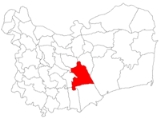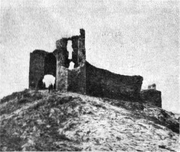
Sarichioi
Encyclopedia
Sarichioi is a commune in Tulcea County
, Romania
. It is composed of five villages: Enisala, Sabangia, Sarichioi, Zebil and Visterna. Besides the ethnic Romanian
majority (54% of the population), the commune is home to a sizable Lipovan community (46%).
 The village of Enisala (Turkish
The village of Enisala (Turkish
for "New Village", from the Bulgarian
Ново село) is the site of a fortress dominating nearby lakes (previously gulfs) of Razelm and Babadag. Dated to the late 13th century, it was built either by the Genoese
or the Byzantines
to control the travel routes that passed through the region. The fortress' three hexagonal towers are the only of this type found in the whole region of Dobruja
, and have been interpreted as a sign of a Western origin of the builders. The fortress was first conquered by the Ottomans in 1388/1389, and retaken in 1416/1417 after a brief Wallachia
n rule. Due to the new political situation and the development of sand spits that hampered trade, the fortress gradually decayed, and was finally abandoned around the end of the 15th century.
Tulcea County
Tulcea is a county of Romania, in the historical region Dobruja, with the capital city at Tulcea.-Demographics:In 2002, Tulcea County had a population of 256,492...
, Romania
Romania
Romania is a country located at the crossroads of Central and Southeastern Europe, on the Lower Danube, within and outside the Carpathian arch, bordering on the Black Sea...
. It is composed of five villages: Enisala, Sabangia, Sarichioi, Zebil and Visterna. Besides the ethnic Romanian
Romanians
The Romanians are an ethnic group native to Romania, who speak Romanian; they are the majority inhabitants of Romania....
majority (54% of the population), the commune is home to a sizable Lipovan community (46%).

Turkish language
Turkish is a language spoken as a native language by over 83 million people worldwide, making it the most commonly spoken of the Turkic languages. Its speakers are located predominantly in Turkey and Northern Cyprus with smaller groups in Iraq, Greece, Bulgaria, the Republic of Macedonia, Kosovo,...
for "New Village", from the Bulgarian
Bulgarian language
Bulgarian is an Indo-European language, a member of the Slavic linguistic group.Bulgarian, along with the closely related Macedonian language, demonstrates several linguistic characteristics that set it apart from all other Slavic languages such as the elimination of case declension, the...
Ново село) is the site of a fortress dominating nearby lakes (previously gulfs) of Razelm and Babadag. Dated to the late 13th century, it was built either by the Genoese
Republic of Genoa
The Most Serene Republic of Genoa |Ligurian]]: Repúbrica de Zêna) was an independent state from 1005 to 1797 in Liguria on the northwestern Italian coast, as well as Corsica from 1347 to 1768, and numerous other territories throughout the Mediterranean....
or the Byzantines
Byzantine Empire
The Byzantine Empire was the Eastern Roman Empire during the periods of Late Antiquity and the Middle Ages, centred on the capital of Constantinople. Known simply as the Roman Empire or Romania to its inhabitants and neighbours, the Empire was the direct continuation of the Ancient Roman State...
to control the travel routes that passed through the region. The fortress' three hexagonal towers are the only of this type found in the whole region of Dobruja
Dobruja
Dobruja is a historical region shared by Bulgaria and Romania, located between the lower Danube river and the Black Sea, including the Danube Delta, Romanian coast and the northernmost part of the Bulgarian coast...
, and have been interpreted as a sign of a Western origin of the builders. The fortress was first conquered by the Ottomans in 1388/1389, and retaken in 1416/1417 after a brief Wallachia
Wallachia
Wallachia or Walachia is a historical and geographical region of Romania. It is situated north of the Danube and south of the Southern Carpathians...
n rule. Due to the new political situation and the development of sand spits that hampered trade, the fortress gradually decayed, and was finally abandoned around the end of the 15th century.

